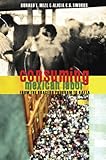Consuming Mexican Labor : From the Bracero Program to NAFTA / Alicia Swords, Ronald Mize.
Material type: TextPublisher: Toronto : University of Toronto Press, [2010]Copyright date: ©2010Description: 1 online resource (304 p.)Content type:
TextPublisher: Toronto : University of Toronto Press, [2010]Copyright date: ©2010Description: 1 online resource (304 p.)Content type: - 9781442601598
- 331.6/272073 22
- online - DeGruyter
| Item type | Current library | Call number | URL | Status | Notes | Barcode | |
|---|---|---|---|---|---|---|---|
 eBook
eBook
|
Biblioteca "Angelicum" Pont. Univ. S.Tommaso d'Aquino Nuvola online | online - DeGruyter (Browse shelf(Opens below)) | Online access | Not for loan (Accesso limitato) | Accesso per gli utenti autorizzati / Access for authorized users | (dgr)9781442601598 |
Frontmatter -- Contents -- List of Tables -- List of Acronyms -- Preface -- Acknowledgments -- Introduction -- Part I: Establishing Connections -- Introduction -- 1. The Bracero Program, 1942–1964 -- 2. Operation Wetback, 1954 -- Part II: Mounting Resistance -- Introduction -- 3. Farmworker Civil Rights Movement/El Movimiento Campesino -- 4. Organized Labor and Mexican Labor Organization -- 5. Backlash and Retrenchment (1980s–1990s) -- Part III: Regions -- Introduction -- 6. Mexican Labor in Aztlán -- 7. Mexican Labor in the Heartland -- 8. Mexican Labor in the Hinterlands -- 9. Mexican Labor en la Frontera -- 10. Mexican Labor in Mexico: The Impact of NAFTA from Chiapas to Turismo -- 11. Mexican Labor in Canada: From Temporary Workers to Precarious Labor -- Conclusion -- Glossary -- References -- Index
restricted access online access with authorization star
http://purl.org/coar/access_right/c_16ec
Mexican migration to the United States and Canada is a highly contentious issue in the eyes of many North Americans, and every generation seems to construct the northward flow of labor as a brand new social problem. The history of Mexican labor migration to the United States, from the Bracero Program (1942-1964) to the North American Free Trade Agreement (NAFTA), suggests that Mexicans have been actively encouraged to migrate northward when labor markets are in short supply, only to be turned back during economic downturns. In this timely book, Mize and Swords dissect the social relations that define how corporations, consumers, and states involve Mexican immigrant laborers in the politics of production and consumption. The result is a comprehensive and contemporary look at the increasingly important role that Mexican immigrants play in the North American economy.
Mode of access: Internet via World Wide Web.
In English.
Description based on online resource; title from PDF title page (publisher's Web site, viewed 01. Dez 2023)


